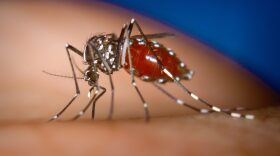Exploration Vessel Nautilus is traveling through never-explored waters near the Hawaiian Islands. The crew aboard E/V Nautilus began their eight-month journey roughly 1,000 miles south of the main Hawaiian Islands near Kingman Reef National Wildlife Refuge and Palmyra Atoll National Wildlife Refuge.
The islands are protected under federal environmental management of the Pacific Remote Islands Marine National Monument (PRIMNM), but the team ventured outside of the territory into waters unexplored by submersibles.
"The main purpose is to establish baselines of what’s down there from a biological and geological perspective," said Steve Auscavitch, one of the lead scientists aboard E/V Nautilus.
"We’re interested in habitat forming species like deep water coral and sponges, and trying to understand the biodiversity associated with these habitats. We’re also trying to understand the history of these seamounts — when they were formed, how old," Auscavitch told HPR.

Auscavitch said the team may have discovered three new species of coral and sponges.
But the process of identifying a new species can take years. Collected samples are sent to the Museum of Comparative Zoology at Harvard University where they go through numerous microscopic tests to determine whether they are truly a new species.
Jordan Akiyama from the U.S. Fish and Wildlife Service is on the vessel to make sure there is no oversampling.
"Because the Pacific Marine National Monuments are protected and overseen by the U.S. Fish and Wildlife Service and NOAA, there’s only so many different biological samples that can be taken from any dive site," Akiyama explained.
The team is also studying the surface of the seamounts in unexplored water to learn more about deep-sea mining for rare earth minerals in areas outside of PRIMNM.
The minerals are used to make batteries for electric vehicles and other technologies to fuel a green-energy economy.




